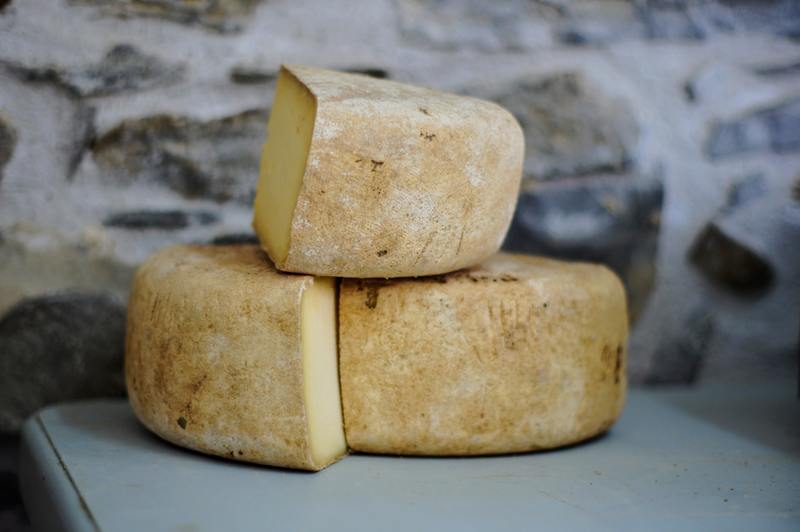Are you concerned about why does cheese mold? Or can you eat cheese with molds?
Do you even know how to properly store cheeses to prevent molding? Then continue reading, for we will help you find the answer.

Maybe you’ve already experienced buying a nice chunk of cheese and then placing it in the fridge for later. As time passed, and you forgot the cheese already.
By the time you opened the fridge to check and assess your stock, something unrecognizable on the corner was already emitting a sour odor. That’s your forgotten cheese with mold growing on it!
What Are The Reasons For Cheese Molding?
According to WebMD, mold is a kind of fungus that consists of small organisms. It flourishes on moisture and reproduces through microscopic spores that travel through the air.
In most foods, mold is a sign of spoilage. Cheeses mold because their main ingredient is milk, but the varieties of milk used differ from various cheeses.
Mold thrives on cheese since there are lots of nutrients there for it to develop. More often, molds grow in cheeses due to exposure to air and moisture.
On a more positive note, some molds are required during the production of certain cheeses. They add unique flavors and mouth feels that have a certain charm to some people.
Some mold-ripened cheeses are:
- Brie
- French Roquefort
- Cheddar
- Swiss
If you are interested in knowing the process of creating cheese, visit here to know how is cheese made.
Are cheeses with mold safe to eat?
Spotting mold on your cheeses doesn’t mean that they have to be thrown out immediately. Molds on soft and hard cheeses receive different treatments.
Molds on hard cheeses rarely spread beyond the surface, so you can salvage it by trimming at least an inch from the portion with mold.
As for mold found on soft cheeses such as cottage cheese, cream cheese, and ricotta, as well as cheeses that were shredded or sliced, it’s better to discard it. Contamination spreads faster here, and some can even acquire dangerous bacteria such as E. Coli and salmonella.
How to know if your cheese has gone bad
Here are ways to help you in identifying if a cheese has turned bad already:
- Expiration date – Yes, we can eat cheese that has passed its expiration date, but it’s not advisable.
- Appearance – It’s easier to see mold growing in the cheese. Most start with a white patch of mold, but for blue cheeses, it’s when the blue veins turn gray.
- Scent – This one is harder to identify since cheese is made from milk curdling, making it smell pungent already.
- Surface quality – Hard cheeses that turned soft; whole cheeses that separated; cheese starting to release oil; or firm cheese that is becoming runny — these are just some of the many signs that you have to assess when it comes to the texture to see if the cheese had gone bad.
Also, remember that hard and soft cheeses may have different characteristics when they are fresh. You must keep that in mind, so you won’t think a soft cheese that was initially soft has turned bad just because of its texture.
Proper Handling Of Cheeses
Although certain molds in cheese can be eaten, not all of us can do it. Here are a few ideas in helping you store and prevent your cheese from growing molds:
- In choosing cheeses with visible packaging, look for a smooth texture. These are free of hardened or yellow patches, splits, or mold growths.
- Eat the cheese as soon as the packaging is undone.
- Know the shelf lives of the different varieties of cheeses when stored in the refrigerator.
Unopened hard cheeses last for 2-4 months, opened ones last for 3-6 weeks, unopened semi-hard cheese lasts for 1-2 months, and opened ones last for 3-6 weeks.
- Label your cheeses with the type and date you bought them, so you can easily keep up on the duration you can store them.
- After each usage, store cheese in the fridge at 40℉ or lower to keep it fresh.
- Keep it in the vegetable drawer or bottom shelf of the refrigerator; the temperature there is consistent. Here’s also a helpful article on preventing mold in refrigerator.
- To keep moisture out, maintain it in a firmly closed container or wrap in plastic wraps or parchment paper.
- Hard cheeses with patches of mold should be trimmed to prevent spreading.
Additionally, if you will deal with lots of molds or are pretty sensitive to molds, read and familiarize yourself with personal protective equipment as it can be helpful in this situation.
Conclusion
To sum it all up, why does cheese mold? It’s for various reasons.
Some are intentionally grown with mold, while others are overexposed to areas where mold grows.
Cheeses with molds aren’t necessarily bad, like hard cheeses where you can trim the mold and still be able to eat it. However, it’s better to proceed with caution when dealing with molded cheese since your health is of the utmost importance.
